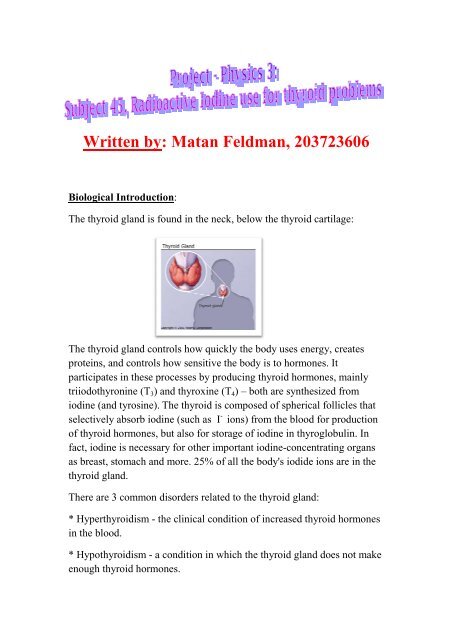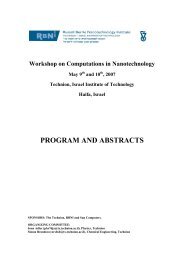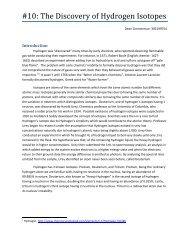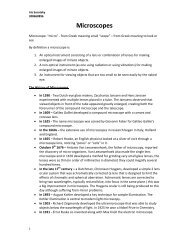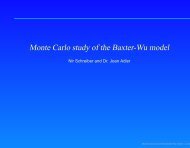Radioactive Iodine use for thyroid problems
Radioactive Iodine use for thyroid problems
Radioactive Iodine use for thyroid problems
Create successful ePaper yourself
Turn your PDF publications into a flip-book with our unique Google optimized e-Paper software.
Written by: Matan Feldman, 203723606<br />
Biological Introduction:<br />
The <strong>thyroid</strong> gland is found in the neck, below the <strong>thyroid</strong> cartilage:<br />
The <strong>thyroid</strong> gland controls how quickly the body <strong>use</strong>s energy, creates<br />
proteins, and controls how sensitive the body is to hormones. It<br />
participates in these processes s by producing <strong>thyroid</strong> hormones, mainly<br />
triiodothyronine (T 3 ) and thyroxine (T 4 ) – both are synthesized from<br />
iodine (and tyrosine). The <strong>thyroid</strong> is composed of spherical follicles that<br />
selectively absorb iodine (such as I - ions) from the blood <strong>for</strong> production<br />
of <strong>thyroid</strong> hormones, but also <strong>for</strong> storage of iodine in thyroglobulin. In<br />
fact, iodine is necessary <strong>for</strong> other important iodine-concentrating<br />
organs<br />
as breast, stomach and more. 25% of all the body's iodide ions are in the<br />
<strong>thyroid</strong> gland.<br />
There are 3 common disorders related to the <strong>thyroid</strong> gland:<br />
* Hyper<strong>thyroid</strong>ism - the clinical condition of increased <strong>thyroid</strong> hormones<br />
in the blood.<br />
* Hypo<strong>thyroid</strong>ism - a condition in which the <strong>thyroid</strong> gland does not make<br />
enough <strong>thyroid</strong> hormones.
* Thyroid nodules: generally benign <strong>thyroid</strong> neoplasms, but may also be<br />
<strong>thyroid</strong> cancers. There most common types of <strong>thyroid</strong> cancers are<br />
papillary carcinoma and follicular carcinoma.<br />
The treatment with RAI (<strong>Radioactive</strong> <strong>Iodine</strong>):<br />
The RAI treatment is based on the fact that the <strong>thyroid</strong> accumulates<br />
iodine and <strong>use</strong>s it in order to produce the mentioned hormones, which are<br />
required <strong>for</strong> normal body function. This RAI is just like the iodine found<br />
in foods such as fish and iodized salt, except that it releases an electron,<br />
or beta particle, which creates its therapeutic action.<br />
There are two radioactive isotopes which are commonly <strong>use</strong>d in patients<br />
with <strong>thyroid</strong> disorders: s: I-123, which is harmless to <strong>thyroid</strong> cells, and I-<br />
131, which destroys <strong>thyroid</strong> cells.<br />
The radiation emitted by each of them can be detected from outside the<br />
patient's body in order to gain in<strong>for</strong>mation about <strong>thyroid</strong> function and<br />
take pictures of the size and location of <strong>thyroid</strong> tissues. The RAI is given<br />
to the patients by mouth in pill or in liquid <strong>for</strong>m.<br />
Usually, the harmless to <strong>thyroid</strong> cells I-123 is <strong>use</strong>d to take pictures and<br />
determine the activity of the intact <strong>thyroid</strong> gland (Thyroid Scan and<br />
<strong>Radioactive</strong> <strong>Iodine</strong> Uptake - RAIU). One benefit of the <strong>use</strong> of I-123 is the<br />
fact that there are no special radiation precautions necessary after a<br />
<strong>thyroid</strong> scan or RAIU.
I-131 can also be <strong>use</strong>d to take pictures of the <strong>thyroid</strong> gland, although it is<br />
rarely <strong>use</strong>d due to its harmful effects on <strong>thyroid</strong> cells.<br />
The hyper<strong>thyroid</strong>ism disease <strong>use</strong>d to be treated by the <strong>use</strong> of Beta<br />
Blockers drugs, but due to the side-effects of these drugs, and the<br />
problematic <strong>use</strong> of drugs in many countries, some patients prefer the RAI<br />
iodine-131 treatment. RAI is <strong>use</strong>d in order to destroy a part of the <strong>thyroid</strong><br />
gland or the whole gland, since the radioactive iodine is selectively taken<br />
up by the gland and gradually destroys the cells of the gland. The RAI<br />
treatment may take up to several months to have its effect, beginning<br />
about two weeks after the treatment.<br />
Alternatively, the gland may be partially or entirely removed surgically,<br />
but iodine treatment is usually preferred by patients, beca<strong>use</strong> the surgery<br />
is invasive and also risks the nerves controlling the vocal cords and the<br />
para<strong>thyroid</strong>. If the entire <strong>thyroid</strong> gland is removed, another <strong>thyroid</strong><br />
disease appears – Hypo<strong>thyroid</strong>ism, which is treated by <strong>thyroid</strong> hormone<br />
replacement.<br />
The I-131 RAI is also given in order to shrink <strong>thyroid</strong> glands that are<br />
functioning normally but are causing <strong>problems</strong> beca<strong>use</strong> of their size, as<br />
with the Goiter brochure.<br />
Large doses of I-131 are <strong>use</strong>d to destroy <strong>thyroid</strong> cancer cells.<br />
Radiation safety precautions after the RAI treatment:<br />
Although the treatments with 131-I are generally safe, it's obvious that<br />
RAI produces some radiation. There<strong>for</strong>e, patients must do their best to<br />
avoid radiation exposure to others, particularly to pregnant women and<br />
young children. Patients may have to stay isolated in the hospital <strong>for</strong><br />
about 24 hours to avoid exposing the radiation to others. The amount of<br />
radiation exposure markedly decreases as the distance from the patient<br />
increases.<br />
Patients who need to travel in the days after I-131 RAI treatment are<br />
carrying a letter of explanation from their physician, beca<strong>use</strong> radiation<br />
detection devices <strong>use</strong>d at airports or in federal buildings could identify<br />
the smallest radiation levels.
The relevant section of the course is (obviously) Nuclear<br />
Physics, Radio activeness.<br />
Sources:<br />
Wikipedia –<br />
* http://en.wikipedia.org/wiki/Thyroid<br />
* http://en.wikipedia.org/wiki/Hyper<strong>thyroid</strong>ism<br />
* http://en.wikipedia.org/wiki/Thyroid_neoplasm<br />
Hadassah institute's website -<br />
* http://www.hadassah.org.il/NR/rdonlyres/4420F310-F6CE-4F5F-<br />
B1D2-<br />
755A25A1052E/3012/%D7%97%D7%95%D7%91%D7%A8%D7%AA<br />
%D7%9E%D7%99%D7%93%D7%A2%D7%99%D7%95%D7%93%D7<br />
%A8%D7%93%D7%99%D7%95%D7%90%D7%A7%D7%98%D7%99<br />
%D7%91%D7%9914105.pdf<br />
American Thyroid Association's website –<br />
*<br />
http://www.<strong>thyroid</strong>.org/patients/patient_brochures/radioactive_iodine.htm<br />
l<br />
Others –<br />
* http://www.abiliko.co.il/index2.php?id=1157&lang=HEB<br />
* http://www.endocrinologist.com/<strong>Radioactive</strong>.html<br />
* http://www.endonurses.org/toolbox/pdf/patient_education/ATA%20<strong>Radioactive</strong>IRAI.pdf


